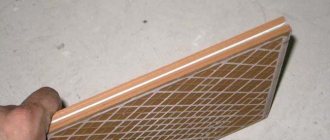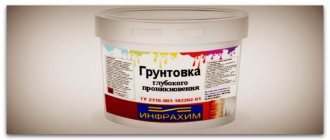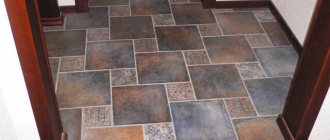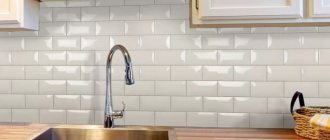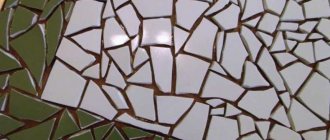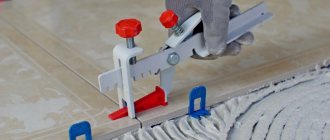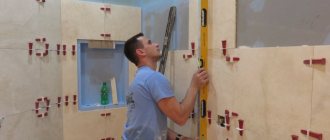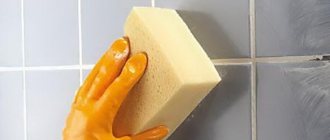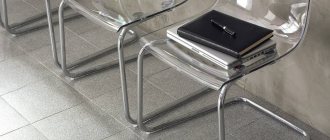Classic ceramic tile format
Throughout the 20th century, in many apartments and houses one could see the decoration of utility rooms, including the kitchen and bathroom, with white ceramic tiles and standard sizes of 10X10 and 15X15 cm.
- The usual size of tiles is considered classic and the most universal, as it is suitable for structures of various purposes and sizes.
- On a surface covered with ordinary tiles of average parameters, an acceptable number of seams is created, with the least waste.
- It is especially in demand for finishing architectural structures of complex geometric shapes.
When laying medium ceramic tiles, wedges are used instead of plastic crosses, which helps to more accurately form the distances between the piece finishing material.
Standard sizes
Standard sizes of tiles for a bathroom, kitchen or any other room are set within 15x15 cm.
The most common variations of square tiles are 10x10 and 20x20 cm.
For walls
Since only square and rectangular tiles are used for wall coverings, products in the 20x20 and 20x30 cm format are considered to be the standard. But the choice of standard tiles does not end there. The most common formats (in millimeters) include:
- 25x150;
- 75x150;
- 100x150;
- 100x200;
- 150x200;
- 150x225;
- 250x300;
- 275x400;
- 150x900;
- 300x900.
Important ! To buy tiles of the required size, you need to adhere to standard rules and calculate the area of the room whose walls will be tiled. Large panels visually narrow the space. The covering scheme and furniture arrangement are important.
For floor
The construction market offers a variety of models that can be joined together during tiled flooring. Because of this, you need to be more careful in choosing building materials. The finishing can be made from fragments of different shapes of the following standard sizes (in millimeters):
- in the shape of a square - 48x48, 100x100, 200x200, 250x250;
- in the form of a rectangle - 100x200, 150 by 200 or 300, 200x300, 300x400;
- in the form of a pentagon - 86.5x150, 98x170, 115x200;
- hexagonal - 150x173, 170x196, 200x230;
- triangular - 58x83, 68x97, 83x118, 98x139.
The assortment also includes non-standard tetrahedral and octagonal elements for floor finishing.
Large format ceramic tiles
Until recently, large ceramic tiles were used to cover large areas of industrial buildings or retail spaces. But recently, large-format tiles have been actively used in the interior design of residential buildings and spacious apartments.
Sometimes it can be seen among the external decoration elements of various buildings. Large tiles include ceramic products with one side measuring from 50 to 120 cm. Most often on sale you can find large tiles with perimeters of 60X90, 90X90, 60X120 cm.
A relatively new variety are elongated tiles, the patterns of which often imitate natural stone or natural wood. They are laid in different ways, including in a herringbone pattern, like parquet.
Among the main advantages of large-format tiles are the following:
- The smallest number of seams between tile units, which helps to perceive the surface as solid.
- The minimum number of tiles in each square meter significantly speeds up the installation process.
- The fewer seams are created when finishing with tiles, the easier it is to maintain and maintain hygiene in the room, since dirt and mold are less likely to form in them.
The largest sized tiles are composite materials, such as porcelain stoneware, and are used for laying floors in rooms with high humidity or for exterior finishing of facades.
Classification of tiles by format
In professional circles, tile sizes are called format. This refers to the area of the product. There are three indicators in total:
When covering walls, you can use all of them, but not every model can be suitable for the floor. In addition to the standard size, the products differ in thickness. For wall structures, thinner types are produced. This is explained by the fact that there is almost no mechanical impact on the surface, unlike the floor. The thinner the tile, the easier it is to lay, and cheaper mixtures can be used to adhere to the wall.
Warning. Floor products can be used on walls, but reverse replacement is not permitted.
Classification is carried out according to form. There are several main types:
Due to inexperience, you can choose a sample of the wrong size. Let's try to understand this difficult matter.
Small or mosaic tiles
Small finishing tiles are considered to be ceramic products whose dimensions are 6X6, 5X5 cm or less. Very small mosaic elements are glued onto strips of fiberglass mesh, together with which they are laid on a cement-adhesive mortar.
Small-sized tiles also have their advantages:
- Beautiful mosaic patterns are selected on a matrix grid, and the cladding masters only have to lay the finished fragments.
- Preparing the surface for laying small tiles does not require special care.
- Smoothly and efficiently covers any bends or waves of a curved surface.
When using small-format mosaic tiles for finishing utility rooms, it should be taken into account that a large number of joints are more dirty and less hygroscopic. Caring for such finishes in the kitchen or bathroom becomes more labor-intensive.
Does size affect quality?
Manufacturers calculate the size and thickness to ensure the material is durable. Therefore, the dimensions of products should not affect quality. Most often, the formation of defects is associated with improper masonry. If the layer of adhesive under the tile is uneven, then the possibility of cracks in place of the voids increases. The glue must be of high quality and applied strictly according to the instructions, observing safety precautions.
When all the rules are followed, the format and thickness are chosen correctly, the coating will last for decades. The final video shows the main parameters of the tile covering:
Suitable wall tile sizes
In the process of specialists acquiring vast practical experience in finishing buildings using tiles, several of the most optimal sizes for laying on walls were identified.
Craftsmen recommend using square tiles with dimensions of 20X20 cm for tiling work in bathrooms or kitchens, and rectangular tiles with sides of 20X30 or 20X45 cm.
Rectangular tiles laid horizontally increase the number of transverse seams and visually expand the space of small rooms. Accordingly, vertically distributed elements of the tiled covering visually increase the height of the walls.
- In bathrooms and bathrooms there is often a need to hide protruding fragments of communications or to tile structures of complex geometric shapes. For these purposes, medium or small format ceramic tiles are used.
- When laying rectangular tiles diagonally, you can smooth out imperfections in the layout of utility rooms, and uneven walls will become less noticeable. To get a brick pattern on the wall, you should choose a rectangular tile, one side of which is twice as large as the other.
For complex modular masonry, carried out by experienced craftsmen, special decorative types of tiles of different sizes are used, some of which can be produced in limited quantities as experimental ones.
Shapes of tiles and their combinations
The best visual result is obtained when a combination of different colors, textures and shapes is used in the cladding. For example, the current top-end “hog” will make the interior somewhat heavier if you use it to decorate a bathroom from floor to ceiling. Therefore, it is recommended to alternate it with a contrasting finish of another kind - for example, painting or artistic plaster.
The same goes for mosaics. At the same time, both the “hog” and mosaic masonry will look impressive as a kitchen apron, setting off the dense panels of the kitchen set.
Features of floor tiles
Products with a thickness of 8 to 11 mm, coated with a hard and wear-resistant protective layer, are suitable for covering the floor with ceramic tiles.
- From medium-sized tiles for the floor, square tiles are purchased in the formats 20X20, 30X30, 330X330, 40X40 and 45X45 cm, as well as rectangular tiles - 10X20, 150X30, 20X30, 30X40 cm.
- In addition to the simple common geometric shapes of tiles for flooring, 5-, 6- and 8-carbon ceramic products are less common. In rooms intended for garages, warehouses or other increased operational loads, the floor is covered with porcelain stoneware.
- This composite material is resistant to mechanical and chemical influences, humidity and fire. Porcelain stoneware goes on sale in the form of rectangular or square tiles, the standard sizes of which are from 20X20 to 60X60 cm.
When choosing tile cladding, you should pay attention not only to its aesthetic qualities, but also to the wear resistance classification, which directly depends on the size of the tile.
More is not better
When choosing a finishing material, there is a great temptation to buy a larger size: they say, less needs to be glued, less hassle. However, keep in mind that the larger the element, the heavier it is, which means there is a high risk that the coating will “float” when gluing. Therefore, for wall tiles there is a thickness limit - from 4 to 9 mm. Accordingly, the thicker the tile, the smaller its area.
Accent walls in the interior
In this article we will talk about several ways to organize an accent wall in the interior.
Another nuance should be taken into account when gluing: the thickness of the adhesive layer. Beginners often believe that the more glue there is, the better it will stick. However, this leads to the fact that the adhesive does not adhere well and the tiles slide off, despite the “crosses”. This is especially offensive when laying out mosaics or complex figures. The optimal amount of solution is from 4 to 8 mm, depending on the size and weight of the panels.
Photos of all sizes of ceramic (tile) tiles for floors or walls
What sizes are flooring products?
For the floor, square tiles of the following sizes are traditionally chosen:
Larger specimens are rarely used. The most common option is 300x300 mm.
Explanation. The thicker the product, the greater the load it must withstand. This has a significant impact on weight.
Rectangular products are used:
Manufacturers are constantly expanding the list and adding new dimensional characteristics.
Warning. The smaller the format, the more labor-intensive the installation.
The best option is:
There are non-standard assortments that are used to create various designs.
Kitchen tiles
The regulation of kitchen floor tiles is not much different from others. The choice depends on the area and interior. It should be noted that small square-shaped samples are often used unless special decoration is provided.
Small kitchen products make the kitchen more comfortable and homely. It is known that using a small format helps to avoid increased waste that occurs when cutting. Often it is necessary to bypass structural elements that differ from rectilinear forms. For safety reasons, it is better to select samples with a rough surface, which will serve as protection against slipping.
What's suitable for the bathroom
The bathroom has a small area. Plumbing pipes may pass through the floor, making installation difficult. Therefore, the best option would be to use medium format products. It is recommended to use a coating with a structured surface. More often they choose tiles with sides of 300x300 mm. and smaller, up to 50x50 mm. Rectangular types from 100x200 to 300x400 mm are used.
In addition to standard ones, unique formats are sometimes used. Large-scale elements serve as a background, and small-scale elements create the desired ornament.
Calculation of the number of tiles for walls
A correctly determined number of elements when purchasing will eliminate several problems: it will allow you to save money and eliminate the need to search for a similar item in cases of miscalculation. What is the formula for simple layout schemes:
- Determine the length and height of each wall. Multiply the obtained values;
- If there is a door or window, their area is subtracted from the area of the specific wall;
- Determine the area of an individual tile;
- Divide the obtained wall values into one tile.
Get the required number of elements for wall cladding in the bathroom. You should add 10 - 15% to the calculated value to compensate for possible losses during cutting and delivery. Complex layouts will require detailed drawings under the guidance of professionals.
Proportionality of the sides of the ceramics and the dimensions of the room
Cladding dimensions and flooring
When choosing floor tiles in a store, you should remember that the format of the cladding should be commensurate with the dimensions of the room. A large area decorated with mosaics will dazzle the eye, and large-sized ceramics will only emphasize the modest square footage of the room and, in addition, will generate more waste in percentage terms. However, on the floor of a small bathroom, mosaics will not only be appropriate, but also spectacular.
The mosaic base has a high coefficient of friction, due to the high density of the tile seams and ensuring the safety of the coating.
Ceramics and wall format
When finishing vertical surfaces, the principle of proportionality should also be observed. Excessively large sheets of even chic tiles on the walls of a small room will bring nothing but a feeling of cramping, and small tiles on spacious walls will look like an awkwardly large mosaic. In addition, the orientation of the ceramic finish on the surfaces is of great importance.
Assortment of ceramic tiles
If the ceiling of the room is disproportionately high relative to the dimensions of the room, then laying the tiles horizontally will reduce this visually, but will add length to the room. And vice versa - vertically laid tiles will help to “raise” the ceilings, but the length of the walls will visually decrease. This principle also applies to adjusting the dimensions of the floor if the tile format is rectangular.
Tile dimensions and joint width
The width of the joints between the tiles must also correspond to the format of the ceramics. Even joints that are consistent in width and rubbed with a colored compound, with a gap of 1-2 mm, will get lost against the background of ceramic tiles 50x50 cm or more. And wide joints are aesthetically inappropriate on small tiles (the exception is technologically necessary expansion joints, which are made on heated floors).
To determine the optimal joint width, first of all, look at the dimensions of the ceramic tiles themselves during the installation planning process.
Features of adhesive solutions
The type of composition also affects the amount of glue. There are 3 types of tile adhesive:
- Cement. The standard mixture contains cement, sand and special additives in the form of plasticizers. An alternative is a homemade solution made from cement, sand and lime. Application of this composition is quite simple and quick.
- Two-component. The composition includes epoxy resin and catalyst. The adhesive has a high density, which allows for high-quality adhesion of the tiles to the wall with minimal mortar costs.
- Dispersive one-component. Such mixtures are sold ready-made and contain various types of resin additives.
Types of floor tiles
Kitchen floor tiles are available on the domestic market in a huge variety of patterns and colors. A professional can help determine which floor tiles are best for the kitchen, taking into account the base material and the personal preferences of the property owner.
You cannot use the same tiles for tiling the floor as for the walls. Manufacturers produce a category of products intended for installation on surfaces that will be subject to increased load during operation.
The following main types of kitchen floor tiles are available on the market:
Dimensions of ceiling tiles
When covering the ceiling with PVC slabs, ventilation is carried out and the desired lighting is installed. The damaged area of the ceiling cladding can be easily replaced. The length of the slab can reach 30 cm, and the thickness is 0.7 cm. The panels are mounted using dowels and self-tapping screws. To install a PVC ceiling panel you will need levels, a hacksaw, a construction knife, a tape measure and a screwdriver.
Foam boards
The correct selection of foam boards allows for easy installation. Most often, white, bluish or beige tiles are purchased. The advantage is that white looks noble and is cheaper than colored ones. It is by no means suitable for cladding walls and floors, since it does not have the same moisture-resistant properties as porcelain stoneware or artificial stone. Such tiles can be decorative due to their beautiful patterns.
Due to the fragility of the foam product, it should be installed very carefully. To increase resistance to moisture, water-based paint is used. Extruded foam tiles cannot be washed. Its thickness does not exceed 0.7 cm.
Injection foam products are waterproof. Their thickness varies from 0.9 to 1.4 cm. Injection foam tiles have soundproofing properties. This foam board is made of self-extinguishing components. This increases the level of fire safety.
Mirror tiles
In conclusion
When planning to decorate a kitchen with ceramic tiles, it is important to be able to correctly combine those elements that are used to cover the walls, work area and floor with each other and with interior items. Each type of tile has its own requirements, but, in any case, great importance must be paid to the appearance of the tile: it must be intact, without chips or cracks, and of the correct geometric shape. Do not forget to pay attention to the marking, because with its help the manufacturer communicates all the qualities of the tile. And lastly, it is better to buy ceramic tiles in trusted places and give preference to products from reputable manufacturers.
The article was written for the site.
Tags:Ceramic tiles, Kitchen
Nuances of choosing facade tiles
When developing a house project, you must consider:
- The dimensions of the tiles affect the visual perception of the building, which is especially important for multi-story buildings. The use of elements of different sizes can give the illusion of volume to planes, examples of which are shown in the video.
- The use of large elements of ceramic cladding is appropriate when there are many decorative elements on the facade.
- The use of mosaics to create, for example, a city landscape is an effective method of decorating a blank end wall during reconstruction.
- Facade tiles can be widely used in the design of kitchens and summer rooms: verandas, loggias, balconies, where they are used for wall cladding or floor ornamentation.
Advice! Over time, ceramic finishes tend to lose the strength of their fastening due to repeated freeze/thaw cycles. As a result, the use of large elements for the design of facades, especially high-rise buildings, can, in the absence of timely repairs, pose a significant danger to the lives of passers-by.
For floor tiles, there are higher requirements for abrasion, surface curvature and size; the so-called rectified tile gauge is most in demand compared to non-rectified ones. Everything is quite simple, the edge of the tile in the entire batch of goods is cut to the same size, it is easy to lay such tiles without fear that the seams will start to leak.
